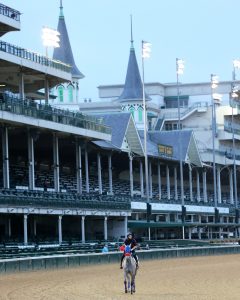The Churchill Downs spring meet is back on schedule, set for opening day on Saturday (April 24). Upon opening, the iconic track will become one of horse racing’s top simulcast signals.
Churchill’s live racing will be held on a mainly four-day-a-week schedule (Thursdays-Sundays) through June 26. The exception, naturally, is Derby Week, which runs from Tuesday-Saturday. The Kentucky Derby 2021 is Saturday, May 1.
But before we get wrapped up in Derby-mania, here are some track trends for handicappers planning on early success at Churchill Downs.
Both racing surfaces, the main track and the turf course, are rather unique in that each has its own quirks handicappers need to understand.

Dream Marie – Courtesy of Churchill Downs/Coady Photography.
Main track: it’s ‘cuppy’
The main track is often regarded as a very “cuppy” surface, meaning the track does not retain enough moisture to hold the sand together. This causes the track to break away from under horse’s feet resulting in footing that some horses love, and others hate.
This factor makes Churchill one of the tracks where the horses-for-courses angle means the most. The track is more likely to be faster and conducive to speed in the summer when temperatures and humidity are higher. Early in the meet, the track is likely to play slower. Speed horses may not excel as much early in the meet as they do as the calendar progresses.
Turf course: a sand-based composition
The turf course is also sand based, making its composition different from most other turf courses with the exceptions of Keeneland and the Fair Grounds. Chances are, if a horse has recently run well on the turf at either of those tracks, that horse’s form will be more reliable at Churchill than turf horses shipping in from elsewhere. The Churchill turf, just like the dirt, is another place where you’ll want to heavily weigh a horse’s past performances specifically on the home track’s oval.
Distance trends
Churchill Downs dirt mile races are run around one turn and play more like sprints than routes. Unless a horse is already a proven one-turn miler, horses stretching from 7 furlongs will do better in those mile races than horses trying to cut back from two-turn route races.
Check the post positions
As a Churchill handicapper, you also must make yourself acutely aware of any inside/outside biases happening at any given meet, and you must pay attention to the rail path because the rail seems particularly susceptible to mostly negative track biases. Keep an eye on how inside-drawn horses are doing at the meet and adjust your handicapping accordingly.
See Also: Belmont Park 2021 Spring Meet: Handicapping Preview
What to look for in turf races
The turf course is generally fair to horses breaking from all post positions no further out than post 8. Posts further outside than post 8 are at a bit of a disadvantage. The turf distance that is most affected by post positions is a flat mile, where the win percentages for outside posts drop to an extremely poor average of 3-4% each. Take note also, that at a mile, middle posts 4-7 tend to be the best at that distance.
Even more so than post positions, the main thing you’ll want to take into account on the Churchill Downs lawn is a horse’s running style. Churchill’s turf course favors mid-pack pace-pressers and stalkers strongly over all other running styles. Early leaders generally have a difficult time going wire-to-wire on this turf course, and the deepest of closers have a tough time getting up in time to win. This analysis is especially true in 1-mile turf races, where early speed horses win less than 10% of the time, and closers coming from further than 10 lengths behind win even less. The ideal winning profile in Churchill turf routes is a stalker that runs about four lengths off the pace at the first call (half-mile), and 2 1/2 lengths behind at the second call (6-furlong mark).
In Churchill’s short turf sprints, early speed certainly comes in handy, but it is not a must to be successful. Many of the best turf sprinters that show up at Churchill will be coming up from winter stints at Gulfstream, and these horses should hold an advantage over local horses returning from layoffs early at the meet. Gulfstream’s turf sprints strongly favor speed horses, so if you see stalkers or closers arriving in these races off recent losses at Gulfstream, you might want to upgrade those horses at Churchill because their running style plays better here. Plus, these horses might be overlays based on Gulfstream losses where they ran out of real estate chasing speedy front-running winners.

Noel Michaels has been involved in many aspects of thoroughbred racing for more than two decades, as a Breeders’ Cup-winning owner and as a writer, author, handicapper, editor, manager and promoter of the sport for a wide range of companies including Daily Racing Form and Nassau County Off-Track Betting.
He also is regarded as the leading source of news and information for handicapping tournaments and the author of the “Handicapping Contest Handbook: A Horseplayer’s Guide to Handicapping Tournaments”, which made his name virtually synonymous with the increasingly-popular tournament scene.
In addition to contributing to US Racing, he is also an analyst on the Arlington Park broadcast team.


